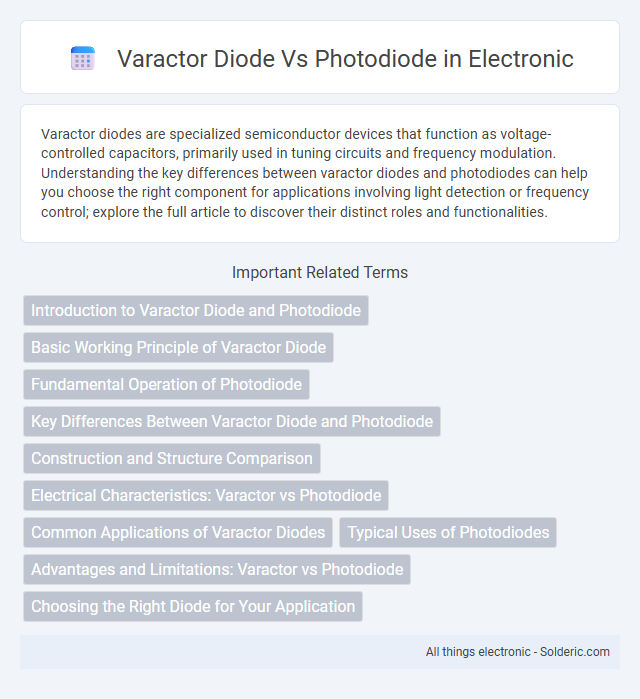Varactor diodes are specialized semiconductor devices that function as voltage-controlled capacitors, primarily used in tuning circuits and frequency modulation. Understanding the key differences between varactor diodes and photodiodes can help you choose the right component for applications involving light detection or frequency control; explore the full article to discover their distinct roles and functionalities.
Comparison Table
| Feature | Varactor Diode | Photodiode |
|---|---|---|
| Function | Voltage-controlled capacitance | Light to electrical current conversion |
| Operation Principle | Varies junction capacitance with reverse bias voltage | Generates photocurrent when exposed to light |
| Application | Tuned circuits, voltage-controlled oscillators (VCOs) | Optical communication, light sensing, photometry |
| Biasing | Reverse bias voltage | Reverse biased for photoconductive mode or zero bias for photovoltaic mode |
| Response Speed | Not applicable (capacity changes with voltage) | Fast response, nanosecond range |
| Spectral Sensitivity | Not applicable | Visible to near-infrared spectrum |
| Device Structure | P-N junction diode optimized for capacitance variation | P-N or PIN junction diode optimized for light detection |
| Output | Capacitance varies with voltage | Current proportional to incident light intensity |
| Typical Materials | Silicon (Si) | Silicon (Si), Germanium (Ge), Indium Gallium Arsenide (InGaAs) |
Introduction to Varactor Diode and Photodiode
Varactor diodes are semiconductor devices that exploit the voltage-dependent capacitance of a reverse-biased p-n junction, commonly used in frequency tuning applications like voltage-controlled oscillators. Photodiodes convert light into electrical current by absorbing photons, making them essential in optical communication systems and light sensing. Understanding your specific application requirements helps determine whether the varactor diode's tunability or the photodiode's light sensitivity is more suitable.
Basic Working Principle of Varactor Diode
The basic working principle of a varactor diode relies on the voltage-dependent capacitance of its p-n junction, which acts like a variable capacitor when reverse biased. Changes in the reverse voltage alter the depletion region width, thereby varying the junction capacitance used for tuning circuits in RF and microwave applications. Unlike photodiodes that convert light into current, varactor diodes are primarily used for electronic tuning and frequency modulation due to their voltage-controlled capacitance characteristics.
Fundamental Operation of Photodiode
A photodiode operates by converting light into an electrical current through the photoelectric effect, with photons generating electron-hole pairs in a semiconductor junction. Unlike a varactor diode, which varies its capacitance based on applied voltage, the photodiode's fundamental function is light detection and signal conversion. Understanding your photodiode's operation enables effective use in optical communication, light sensing, and photonic applications.
Key Differences Between Varactor Diode and Photodiode
Varactor diodes are voltage-controlled capacitors used primarily in tuning circuits to vary capacitance with applied reverse voltage, while photodiodes are semiconductor devices that convert light into electrical current in optical sensing applications. Varactor diodes operate under reverse bias to exploit their variable junction capacitance, whereas photodiodes operate under reverse bias to produce photocurrent proportional to incident light intensity. Your choice between the two depends on whether you need electronic tuning capabilities or light detection functionality in your circuit design.
Construction and Structure Comparison
Varactor diodes feature a p-n junction designed to vary capacitance with applied voltage, typically constructed using a heavily doped p-type and lightly doped n-type semiconductor to maximize the depletion region. Photodiodes are constructed with a p-n junction optimized for light absorption, often using materials such as silicon or germanium, with a thin depletion layer to efficiently generate electron-hole pairs upon photon incidence. Unlike varactor diodes, photodiodes integrate anti-reflective coatings and passivation layers to improve light sensitivity and reduce surface recombination.
Electrical Characteristics: Varactor vs Photodiode
Varactor diodes exhibit a voltage-dependent capacitance primarily used for tuning circuits, with low leakage current and high-quality factor (Q), enabling precise control of frequency in RF applications. Photodiodes generate a photocurrent proportional to incident light intensity, characterized by fast response time, low dark current, and high sensitivity to different wavelengths. While varactors operate under reverse bias to modulate capacitance, photodiodes function as photodetectors converting light into electrical signals, emphasizing their distinct electrical behavior and application-specific parameters.
Common Applications of Varactor Diodes
Varactor diodes are primarily used in voltage-controlled oscillators, frequency multipliers, and tunable filters within RF and microwave communication systems. Their ability to vary capacitance with applied voltage makes them essential components in voltage-controlled tuning circuits such as phase-locked loops and frequency synthesizers. Unlike photodiodes, which detect light and convert it into electrical signals, varactor diodes focus on frequency modulation and signal tuning applications.
Typical Uses of Photodiodes
Photodiodes are primarily used in light detection applications such as optical communication systems, safety equipment, and light measurement devices due to their high sensitivity to light intensity. Unlike varactor diodes, which are utilized for tuning and frequency modulation in RF circuits, photodiodes convert light into electrical signals, enabling precise light sensing and fast response times. Your choice of photodiode will depend on factors like spectral response, speed, and sensitivity for applications including barcode scanners, medical devices, and environmental monitoring.
Advantages and Limitations: Varactor vs Photodiode
Varactor diodes offer precise voltage-controlled capacitance tuning, making them ideal for frequency modulation and voltage-controlled oscillators but have limited sensitivity to light. Photodiodes excel in converting light into electrical current with rapid response times and high sensitivity, crucial for optical communication systems, yet they require careful biasing and can be affected by ambient light noise. Your choice between a varactor diode and a photodiode depends on whether your application prioritizes electronic frequency modulation or sensitive light detection.
Choosing the Right Diode for Your Application
Choosing the right diode involves understanding the distinct functions of varactor diodes and photodiodes; varactor diodes serve as voltage-controlled capacitors for tuning circuits, while photodiodes are designed to detect light and convert it into electrical signals. Applications requiring frequency modulation or voltage-variable capacitance benefit from varactor diodes, commonly used in RF design and voltage-controlled oscillators. Conversely, photodiodes are essential in optical communication, light sensing, and imaging systems, where efficient and sensitive photodetection is critical.
Varactor diode vs Photodiode Infographic

 solderic.com
solderic.com